What defines trees with purple flowers?
There is no scientific definition of a tree. But in simple terms, a tree is a plant that has a single woody stem or trunk, with multiple lateral branches (grow out to the sides).
A plant that has several woody stems growing from the base is called a shrub. Shrubs generally don’t grow as tall as trees, but sometimes the two can overlap.
For the purposes of this article, a purple flowering tree is a plant with a single woody trunk and grows to more than 10 feet tall (3.5 m) at maturity.
Why Grow Purple Flowering Trees?
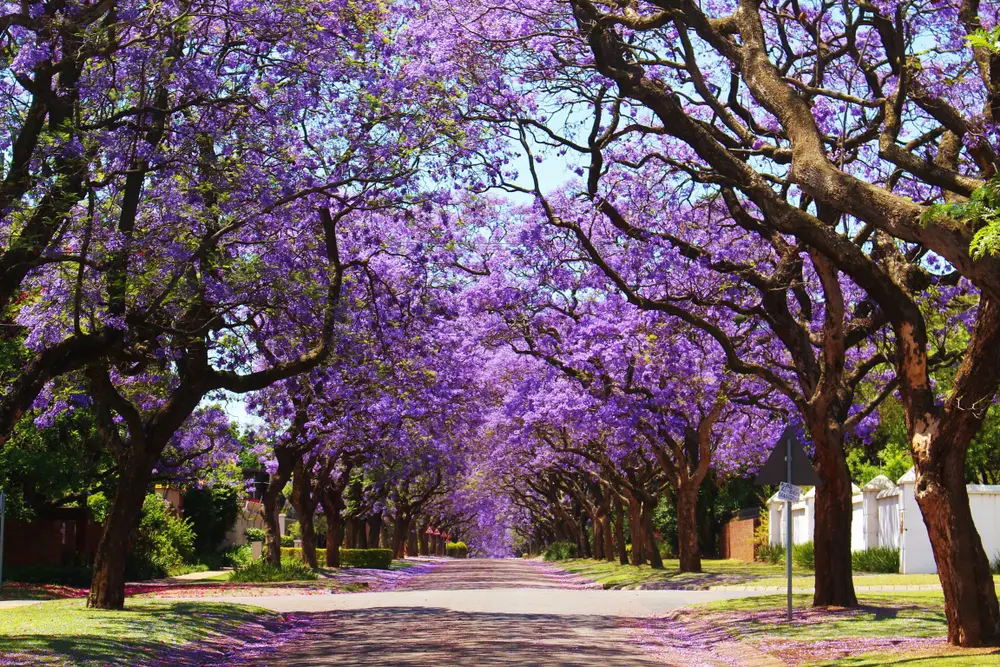
Purple is a color that makes us feel calm and relaxed. Darker shades can bring feelings of power or strength. Throughout history, the color purple has been associated with royalty.
Purple flowering trees can add some serenity to the garden. Some of them put on a fabulous show of color in the spring to bring an end to the dreary days of winter, while others flower later in the season when many flowering plants are done.
Many of the purple flowering trees also offer lovely refreshing or soothing scents to wash over the garden.
Purple Flower Tree Identification Guide
Describing a color can be a bit of a challenge. One person’s “red” is another person’s “orange.”
So when I say “purple flowering trees” I mean ones with flowers that have a definite blue tinge to them. Think flowers on a lavender plant, or for a sports reference, the team jerseys of the Minnesota Vikings or Kansas State Wildcats.
Brighter colors, like fuchsia or bubblegum, I think of as “pink” flowers. Also nice in a garden, but not the focus of this article.
Planting And Maintaining Purple Flower Trees

Best Planting Practices
Regardless of what type of tree you’re planting, it’s important to follow proper planting techniques to ensure the tree’s long and healthy future. A tree planted incorrectly, may look fine for a year or two – or more – and then suffer sudden die back for no apparent reason. The problem may lie beneath the soil, in girdling roots that eventually got strangled and stopped functioning. Or it may simply languish after planting and never look quite right.
It’s also best to plant trees in the early fall, when temperatures aren’t as hot – and will stress a tree less – and the soil is still warm enough for good root growth. Yes, you can plant in the late spring as well, but this means more stress on the tree as it tries to establish a new root system in the heat of summer.
Be aware that even if you do everything right, a tree will take at least a year to establish in its new home. It will be putting all its energy into growing a new root system, and ignoring its topgrowth. So you may not see any flowers on your tree for at least one year after planting. If you plant it in the spring, it may flower that first season – depending on the variety – but might skip a year before it flowers again.
Common Maintenance Tips
Regularly check for signs of disease or pests, and address any issues promptly to promote healthy growth.
Consistently water, especially during dry spells. Deep watering is more beneficial than frequent light watering, as it encourages deep root growth.
Mulching around the base of the tree helps retain moisture, suppress weeds, and regulate soil temperature.
Choosing The Right Trees With Purple Flowers For Your Garden
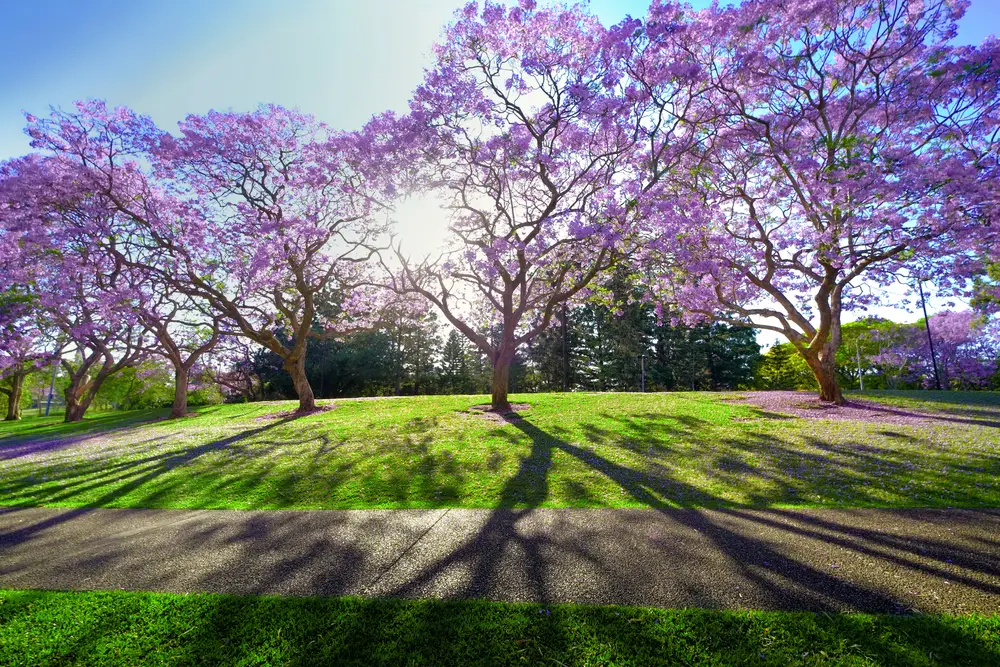
When selecting a purple flowering tree, start by assessing your garden space. Ensure the tree’s mature size fits comfortably without overcrowding nearby plants. Consider growth rates as well, some trees flourish quickly, while others take their time.
Maintenance is another key factor. Choose varieties that match your gardening style, whether you prefer low-maintenance options or don’t mind a bit of extra care.
Notable choices include the stunning Jacaranda, with its cascading lavender blooms and the “Black Diamond Purely Purple” Crape Myrtle. Each adds a touch of drama and beauty and both are low maintenance, making them excellent additions to any garden!
See the information tables below for detailed guidance on the care and maintenance of each tree.
Seasonal Considerations For Purple Flowering Trees
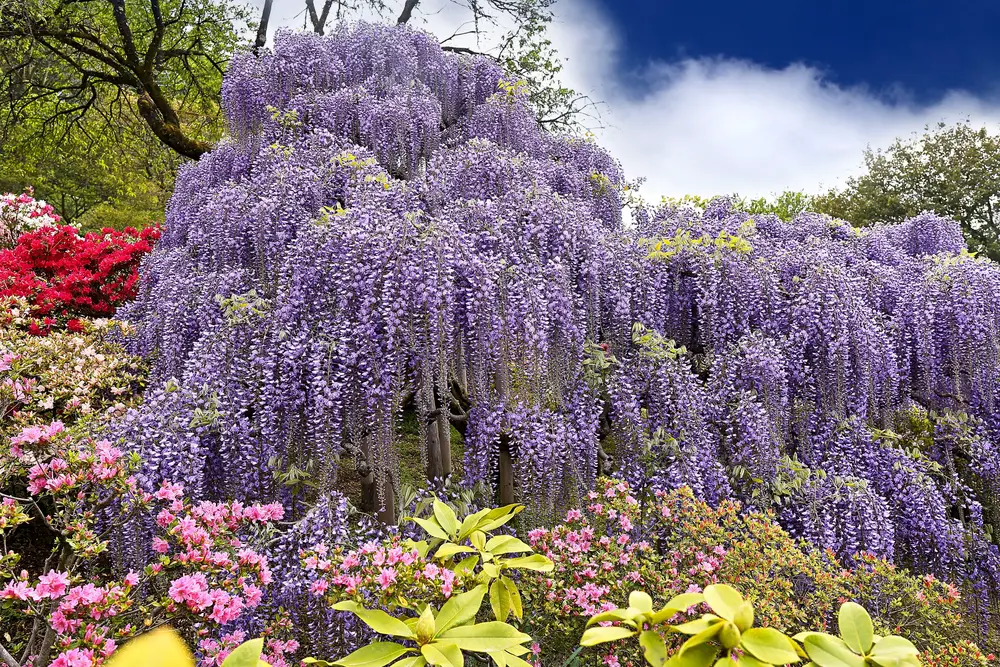
When do different purple flowering trees bloom? It depends on the tree!
Lavender Twist Redbud and Wisteria are perfect examples of spring-flowering purple trees. Others such as the ‘Boomerang’ Lilac variety bloom in spring and again in the fall.
When choosing trees for your landscape, it’s nice to have some variety. You’ll also want to have some visual interest for all seasons. Try a mix of trees, some that drop their leaves for the winter (deciduous) and others some that keep their leaves all year (evergreen). The evergreens form the anchor for your overall landscape.
Deciduous trees provide visual interest with their leaves and flowers in the spring and summer, and often offer beautiful displays of fall color before their leaves drop in the autumn. Many also have interesting bark or shapes to their bare branches in the winter.
Common Issues With Purple Flowering Trees
Common Pests And Diseases
Trees can be susceptible to various pests and diseases that threaten their health. Common problems include
- Aphids: which suck sap and can cause leaf distortion
- Bark beetles: known for burrowing into tree bark and compromising structural integrity
- Fungal diseases: powdery mildew and root rot often arise in conditions with poor airflow or overwatering
Pruning And Disease Prevention
Pruning can help maintain tree health and prevent disease. By removing dead or crowded branches, you improve airflow and light penetration, which helps reduce the risk of fungal infections.
Keep a close watch on your trees for any early signs of pests or disease, as prompt action can make a big difference. Healthy trees are naturally more resilient, so ensure they receive proper watering, mulching, and fertilization to support their growth.
PURPLE FLOWERING TREES
Here are 9 of my favorite purple flowering trees.
1 – Jacaranda (Jacaranda mimosifolia)
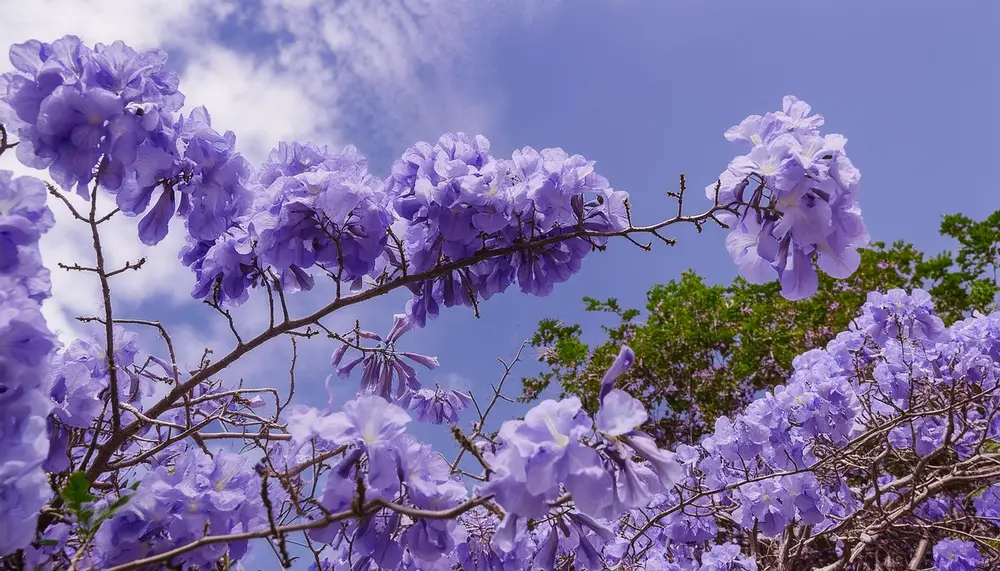
The Jacaranda tree puts on a fantastic show of flowers in spring to early summer when the fragrant blue-purple flowers cover the tree. Its leaves are finely divided, made up of several smaller leaflets. They give the tree a fern-like appearance.
The tree’s arching branches form a large wide canopy. It can grow up to 10 feet a year in its native tropical habitat but is otherwise a moderate grower when planted elsewhere. The more heat and humidity it gets, the happier it will be.
Choose a planting site carefully. It has extensive surface roots that can sometimes be problematic for pathways and structures.
Note: In more tropical regions, the Jacaranda may be considered invasive
| Origin | South America |
| USDA Hardiness Zone | 10-11 |
| Evergreen or deciduous | Deciduous |
| Mature height and spread | 15-20 feet (4.5 – 7 m) tall x 15- 30 feet (4.5- 10 m) wide |
| Growth rate | Fast-growing in warm humid climates |
| Season of flower | Summer (June-July) |
| Sun exposure | Full sun |
| Soil | Sandy well-drained; prefers slightly acid soil |
| Watering | Medium water needs; keep soil evenly moist |
| Maintenance | Minimal |
2 – Black Diamond Purely Purple Crape Myrtle (Lagerstroemia Indica x ‘Purely Purple’)
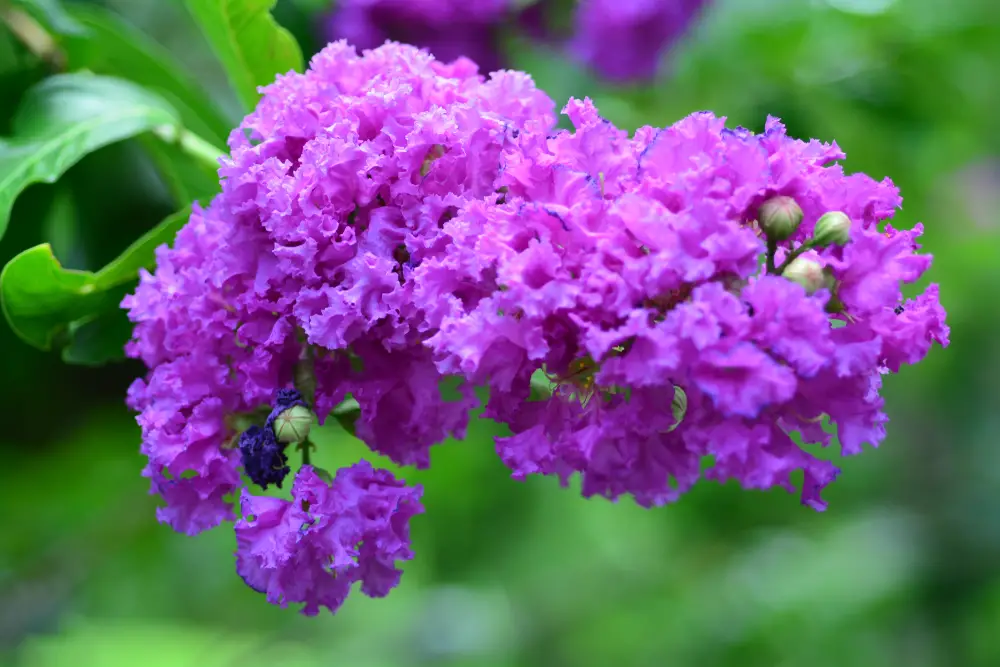
The ‘Purely Purple’ Crape Myrtle sits on the border between being a tree and a shrub. But I had to include it in this list because it does such great double-duty in the landscape. With stunning almost-black summer foliage that turns burgundy in the fall, it adds drama. On top of that, it also produces frilly bright purple (almost fuchsia) flowers at the ends of its branches all season long that add gorgeous contrast to the leaves.
It can tolerate urban pollution. This, plus its size, makes it a perfect choice for small city gardens.
| Origin | China |
| USDA Hardiness Zone | 7-10 |
| Evergreen or deciduous | Deciduous |
| Mature height and spread | 10-12 feet (3 – 4 m) wide x 8 feet (2.5 m) wide |
| Growth rate | Fast-growing |
| Season of flower | Late spring through fall |
| Sun exposure | Full sun to part shade |
| Soil | Rich acidic soil |
| Watering | Low to moderate |
| Maintenance | Minimal |
3 – Lavender Twist Redbud or Covey Redbud (Cercis canadensis ‘Covey’ or ‘Lavender twist’)

This redbud barely meets my 10-foot (3.5 m) definition of a tree, but it was worth a place on this list because of its many seasons of interest, and its attractive weeping habit.
In spring, it produces masses of lavender pink pea-like flowers in clusters that cover the weeping branches before the leaves emerge. This dramatic flower show lasts for several weeks.
The heart-shaped leaves are green in summer and turn shades of golden yellow in the fall.
It doesn’t transplant well once established, so think carefully about where you want to put it in your landscape.
| Origin | North America |
| USDA Hardiness Zone | 5-9 |
| Evergreen or deciduous | Deciduous |
| Mature height and spread | 4-10 feet (1.3 – 3.3 m) tall and wide |
| Growth rate | Slow |
| Season of flower | Spring |
| Sun exposure | Full sun to part shade |
| Soil | Average, well-drained |
| Watering | Regular consistent moisture |
| Maintenance | Low |
4 – Common Lilac or French Lilac (Syringa vulgaris)
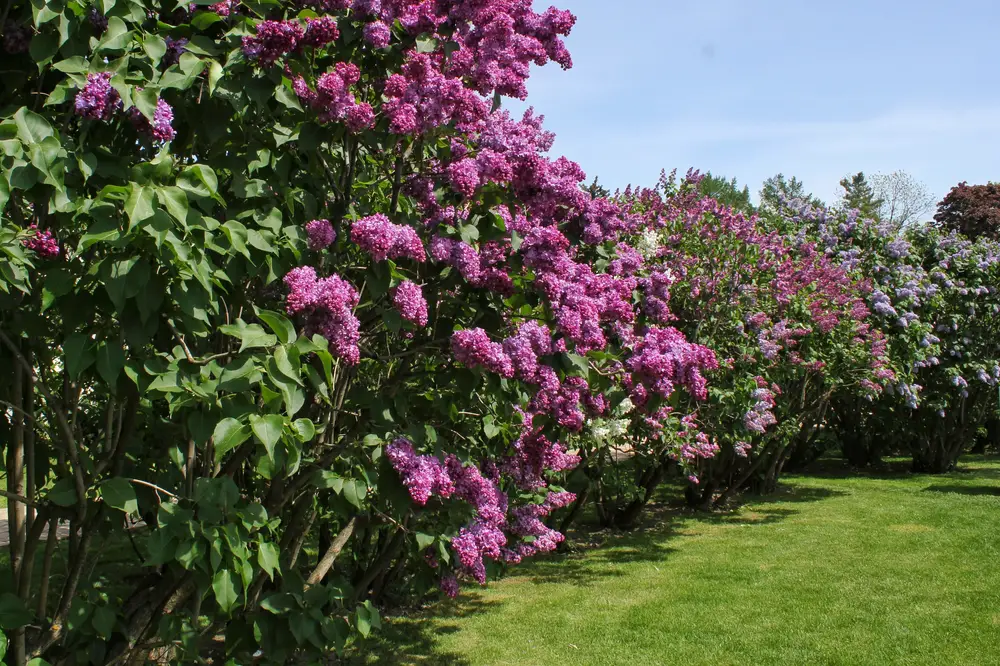
The common lilac is a familiar sight in many gardens. It is loved for its beautiful and fragrant flowers that signal summer is just around the corner. The fragrance brings on a sense of nostalgia to anyone who grew up with them.
Lilacs are more of a shrub, producing multiple trunks and suckers at soil level. These can be pruned back and the plant trained to grow more of a tree shape.
The flowers appear in late spring. They are 8 inches (20 centimeters) long cone-shaped clusters, made up of several smaller flowers. They grow on the tips of the branches. Spent flowers can be pruned at the base to encourage better flowering the following year.
The common lilac has an upright but irregular-shaped growth habit suited to the back of the garden where it can form a nice green backdrop once it finishes flowering. But you might also want to plant it near a deck or patio where the fragrance can be enjoyed and where its branches can provide shade during the hot summer months.
There are many new varieties of lilac available on the market with flower colors ranging from the traditional light purple to deep purple/magenta, white and pale yellow. Some are dwarf varieties better suitable for smaller spaces. Some called ‘Boomerang’ bloom in spring and again in the fall. Varieties with purple flowers include ‘Miss Kim’ ‘Sensation’ ‘President Lincoln’ and ‘Ludwig Spaeth.’
| Origin | Southern Europe |
| USDA Hardiness Zone | 3-7 |
| Evergreen or deciduous | Deciduous |
| Mature height and spread | 15 feet (5 m) tall x 10 feet (3.3 m) wide |
| Growth rate | slow |
| Season of flower | Late spring |
| Sun exposure | Full sun |
| Soil | Rich, well-drained |
| Watering | Average |
| Maintenance | Low |
5 – Rose of Sharon (Hybiscus syriacus ‘Blue Chiffon’)
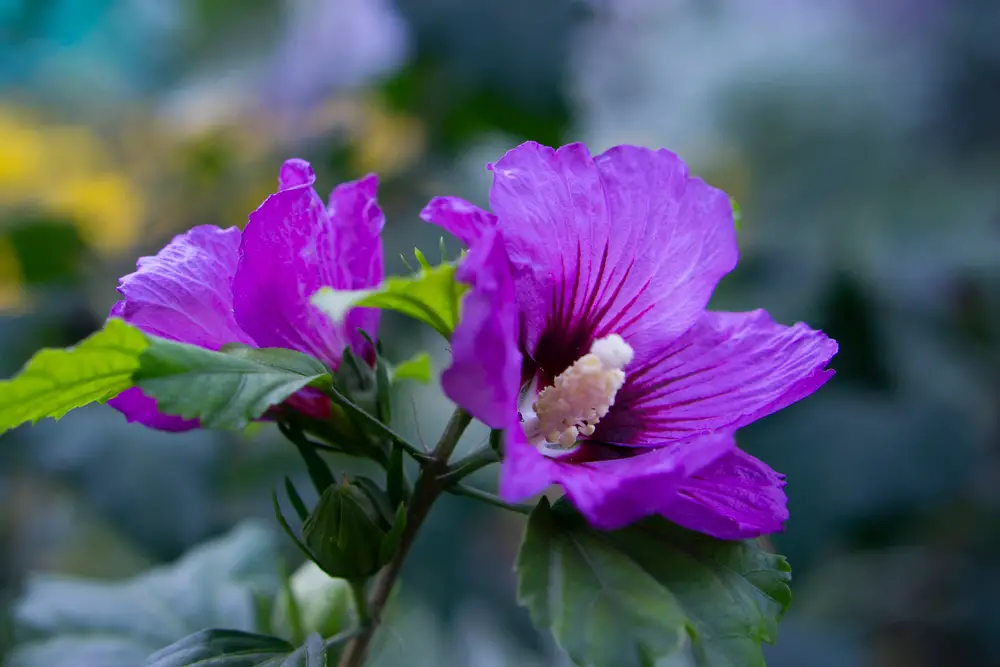
The Rose of Sharon is another one of those tree/shrub plants that could fall into either category. There are several varieties, known mostly for their pale pink or white flowers. The variety ‘Blue Chiffon’ sports a soft lavender-blue frilly double flower.
‘Blue Chiffon’ has a tall upright vase-shaped growth habit. It flowers best in full sun but can tolerate some shade. It flowers over several weeks from early summer through to early fall.
Rose of Sharon blooms on new wood (i.e. new branches that grow in the spring will flower that summer). They can be pruned in early spring if necessary (e.g. to control size or shape) but pruning isn’t required.
| Origin | China, India |
| USDA Hardiness Zone | 5-9 |
| Evergreen or deciduous | Deciduous |
| Mature height and spread | 12 feet ( 4 m) tall x 10 feet ( 3.3 m) wide |
| Growth rate | Slow to moderate |
| Season of flower | Early through late summer |
| Sun exposure | Full to part sun |
| Soil | Well-draining |
| Watering | Medium |
| Maintenance | Minimal |
6 – North American Wisteria (Wisteria frutescens) Japanese Wisteria (Wisteria floribunda) or Chinese Wisteria (Wisteria sinensis)
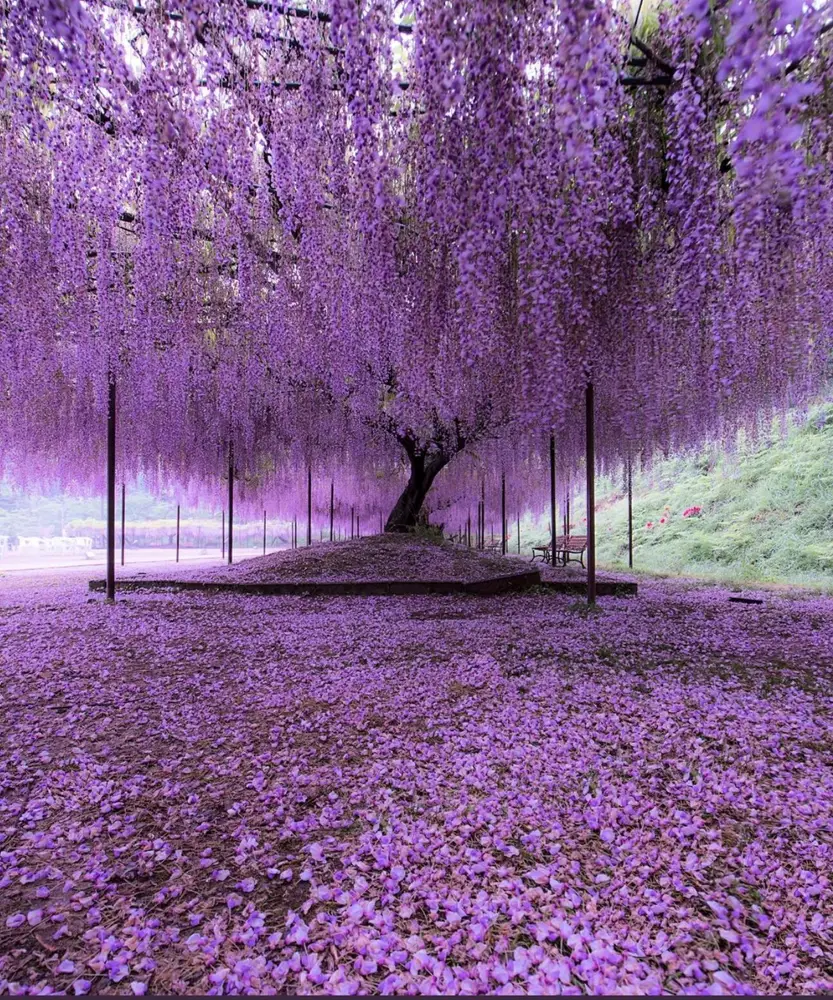
Wisteria is a climbing vine. But I’ve included it as a tree because it is long-lived and can be trained to grow in the shape of a tree. It takes some effort and time (on an annual basis) but the results can be spectacular.
The more widely-known wisteria varieties are Japanese (Wisteria floribunda) and Chinese (Wisteria sinensis). As their names suggest, they are native to Asia. They are very vigorous growers and in some regions are considered invasive.
There is also a North American variety native to the eastern U.S. states, Wisteria frutenscens. It too is a fast-growing vine, but tends to be less aggressive than the Asian varieties. Any variety may be trained into the shape of a tree but the less vigorous American variety may be easier to maintain.
Wisteria are known for their prolific long strands of pale purple flowers that hang down from the vines in spring. The Asian varieties flower before the leaves appear, whereas the American variety flowers and leaves appear at the same time. The leaves are long and pinnate, made up of several smaller leaflets.
Training a wisteria into tree-form is fairly straightforward, but requires yearly pruning to maintain its form. After planting the wisteria, a stake is installed close to the plant. If there is more than one vine on the plant, all but the largest most vigorous one is pruned off. The remaining vine is then tied securely to the stake in several spots so that it is kept upright. This vine will remain tied to the stake so that as the plant matures, the vine develops a thick trunk-like form.
To maintain the overall tree shape of a wisteria, the vine requires a lot of careful pruning each season. Otherwise, it will quickly revert into a trailing vining plant.
| Origin | Asia, North America |
| USDA Hardiness Zone | 5-9 |
| Evergreen or deciduous | Deciduous |
| Mature height | Vines can grow more than 50 feet (17 m). Tree form can be trained to any height. |
| Growth rate | Vigorous |
| Season of flower | Spring |
| Sun exposure | Full sun |
| Soil | Moist, well-drained |
| Watering | Moderate |
| Maintenance | High |
7 – Chaste tree ‘Shoal Creek’ (Vitex agnus-castus ‘Shoal Creek’)

There are several varieties of chaste tree.
‘Shoal Creek’ has a rounded growth habit, developing a wide and open canopy. Compound palmate leaves (having several segments like a fan on one leaf) are gray-green and pleasantly aromatic. Conical clusters up to 12 inches (30 centimeters) long of small fragrant pale purple flowers appear at the tips of new growth July through August.
Chaste trees require the opposite care of most other trees: they dislike nutrient-rich soils or organic mulches that retain too much moisture!
For the first couple of years after planting, water your chaste tree regularly and deeply so the water sinks well down into the soil. This encourages a deep root system that will enable the tree to tolerate drought conditions after a couple of years. After the third year, watering frequency can be reduced.
‘Shoal Creek’ is a good choice for providing a bit of shade to a patio, where its fragrant foliage and flowers can be enjoyed.
| Origin | Southern Europe, Asia |
| USDA Hardiness Zone | 6-9 |
| Evergreen or deciduous | Deciduous |
| Mature height and spread | 12 feet (4 m) tall and wide |
| Growth rate | Fast |
| Season of flower | Summer |
| Sun exposure | Full sun |
| Soil | Fast-draining, nutrient-poor |
| Watering | Drought tolerant once established |
| Maintenance | Medium |
8 – Texas Mountain Laurel (Sophora secundiflora)
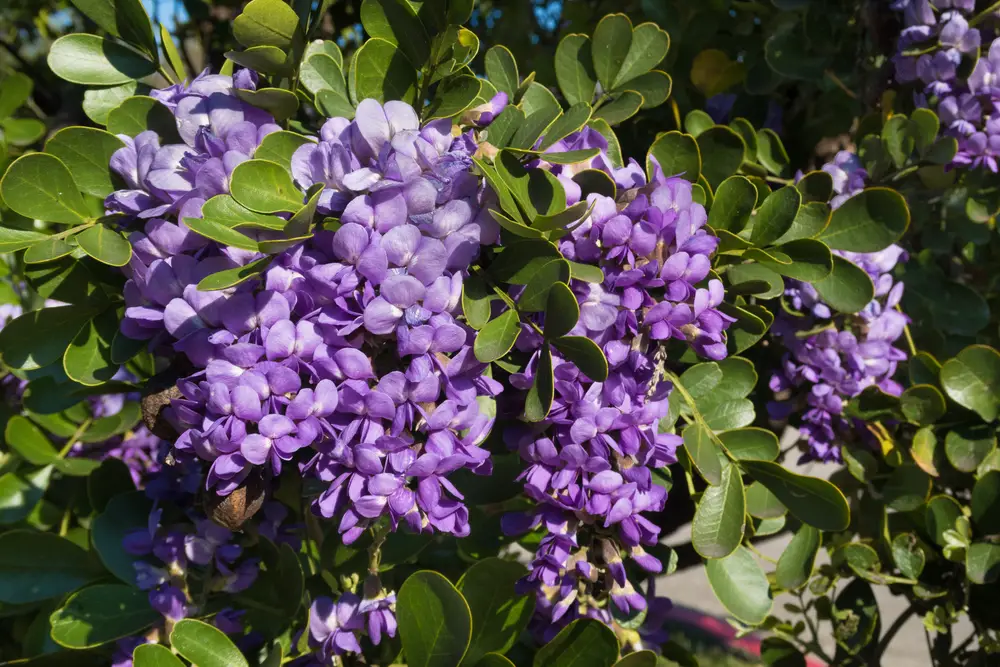
Texas mountain laurel is a shrub that can be trained into a single-trunk tree. In the spring, it bears masses of dense hanging clusters of very fragrant light-purple flowers. They look similar to wisteria flowers.
The flowers are followed by long fuzzy gray seed pods that decorate the tree until fall.
Texas Mountain Laurel is a tough plant. It tolerates extreme heat and drought conditions and can grow in nutrient-poor alkaline soils.
Caution: The flowers and seeds are poisonous. Poisonous elements are similar to nicotine in toxicity. Keep pets and children away from this plant.
| Origin | Texas, New Mexico, Mexico |
| USDA Hardiness Zone | 7-10 |
| Evergreen or deciduous | Evergreen |
| Mature height and spread | 15-25 feet (4.6-7.6 m) tall and 8-10 (2.4-3 m) feet wide |
| Growth rate | Slow |
| Season of flower | Spring |
| Sun exposure | Full sun to part shade |
| Soil | Average alkaline, dry to medium moisture, well-draining |
| Watering | Tolerates seasonal drought once established |
| Maintenance | Low |
9 – Royal Purple Smokebush (Cotinus coggygria ‘Royal Purple’)
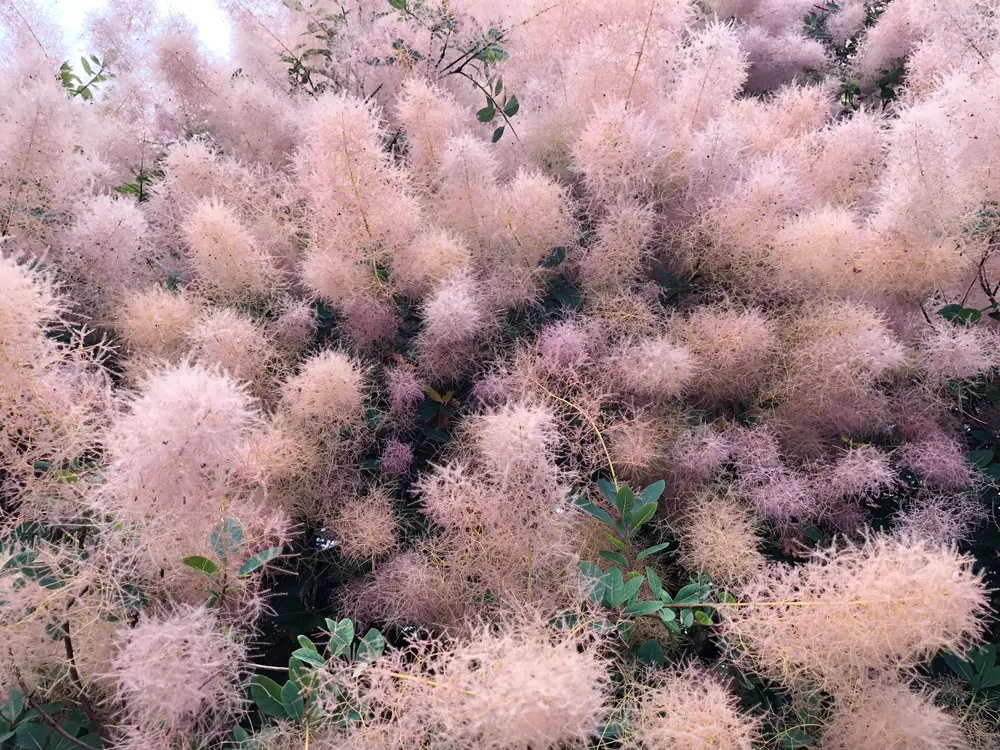
Smokebush is a tall multi-stemmed shrub but can be trained to a single tree-like trunk. In spring, the leaves of ‘Royal purple’ emerge a deep maroon-red, turning to a dark dusty purple as the summer wears on.
Its small yellow flowers are insignificant. What makes this shrub a show-stopper are the airy fluffy seed heads that come after. They’re what give the plant its common name “smokebush” because they look like puffs of purple-red smoke all over the plant. They last for several weeks.
Smokebush is an easy-care plant. It tolerates nutrient-poor rocky soils and is drought-tolerant once established. It needs little pruning except to maintain its shape. It can be pruned back hard in spring every few years to encourage new growth that will have bigger leaves with richer coloring.
| Origin | Southern Europe, China |
| USDA Hardiness Zone | 4-10 |
| Evergreen or deciduous | Deciduous |
| Mature height and spread | 10-15 feet (3-5 m) tall x 15-20 feet (5-7 m) wide |
| Growth rate | Moderate |
| Season of flower | Late spring to summer |
| Sun exposure | Full sun |
| Soil | Average, well-draining |
| Watering | Drought-tolerant once established |
| Maintenance | Medium |